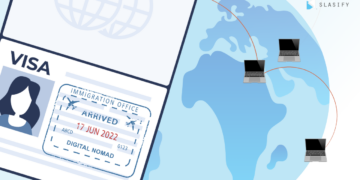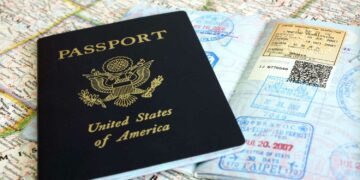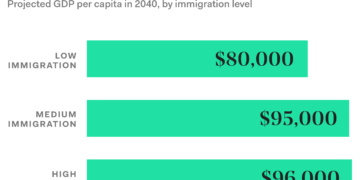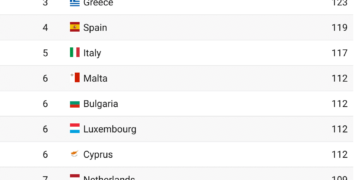[ad_1]
The Division of Homeland Safety (DHS) lately withdrew two guidelines proposed by the Trump administration. On the floor, it appears they don’t have anything in widespread: a proposed enlargement in amassing biometrics and the proposed finish to a program for international entrepreneurs to develop new ventures in the USA. However the withdrawals had a typical goal—encouraging, slightly than curbing, immigration.
The company acted in response to Government Order 14012 that directed companies to “establish any company actions that fail to advertise entry to the authorized immigration system.”
DHS Proposed Rule to Develop Biometrics
U.S. Citizenship and Immigration Companies (USCIS) at the moment collects biometrics (images and fingerprints) from noncitizens who apply for sure forms of immigration advantages, like inexperienced playing cards and for U.S. citizenship. There are age limits on assortment for many advantages requests.
On September 11, 2020, DHS issued a proposed rule that will have vastly expanded biometrics assortment to extra classes of individuals and added different identifiers, like iris photographs and DNA. With no age restrictions and the inclusion of “sponsors,” “petitioners,” or “different particular person submitting for or related to any immigration or naturalization profit,” USCIS might have required biometrics from U.S. residents and from expanded classes of noncitizens.
Through the 30-day remark interval, the company obtained 5,147 feedback that have been principally in opposition to the proposal. Many raised questions on DHS’ authority and expressed public coverage, constitutional, and privateness issues.
DHS withdrew the proposed rule on Might 10. The company discovered current biometrics assortment necessities enough. The company affirmed its assist for the objectives of the proposed rule, like flexibility in biometrics assortment practices and enhanced use to confirm establish, however “not in a means that conflicts with” offering entry to the U.S. authorized immigration system. DHS as a substitute will additional analyze the proposal when it comes to the manager order’s promotion of entry to the authorized immigration system, company insurance policies, and “relevant legislation.”
Any enlargement of biometrics assortment additionally has penalties when it comes to rising USCIS processing instances for functions and petitions.
On March 11, 2019, USCIS started requiring biometrics assortment for Kind I-539, which is filed for a lot of extensions of keep or modifications of standing in nonimmigrant (short-term) classes, together with spouses and youngsters of sure nonimmigrant employees. Important backlogs in processing occurred, which resulted in quite a few lawsuits asking the federal district courts to order USCIS to adjudicate the I-539s and, in some instances, work authorization functions that USCIS wouldn’t course of until it had permitted the nonimmigrant class. The hyperlink between I-539 processing delays and work authorization delays included the spouses of L-1 managers, executives, or specialised data staff who work for multinationals and spouses of sure H-1B specialty occupation employees.
A category motion lawsuit filed in late March 2021 challenged USCIS’ delay in adjudicating Kind I-539s and associated work authorization functions. The grievance included 37 named plaintiffs, whose I-539s to increase their standing (both as H-4 spouses of H-1B employees or as L-2 spouses of L-1 employees) and associated work authorization renewal functions had not been processed. Because of this, they have been both in peril of dropping or had already misplaced their jobs.
In a Might 3 sworn assertion filed on this lawsuit, the Performing Affiliate Director of USCIS Service Middle Operations stated the company had a backlog of roughly 120,000 I-539s for H-4s and L-2s and roughly 57,500 work authorization functions in backlog for H-4s and L-2s. The USCIS official additionally introduced that the company anticipated to droop biometrics necessities starting Might 17, 2021 for I-539s, however with restrictions:
- Just for dependents (spouses or youngsters) in search of extensions of keep in or modifications of standing to E-1, E-2 or E-3, L-2, or H-4.
- I-539 pending on the efficient date with no biometrics discover issued.
- I-539 filed on or after the efficient date.
USCIS will nonetheless have the discretion to require biometrics on a case-by-case foundation. USCIS has included an computerized expiration after 24 months, however the company might affirmatively lengthen it. The suspension will nonetheless depart a considerable variety of functions within the backlog.
DHS Proposed Rule to Finish the Worldwide Entrepreneur Parole Program
The worldwide entrepreneur parole program was established on the finish of the Obama administration in January 2017. Parole is a mechanism by which USCIS could, on a case-by-case foundation, permit a person to be bodily current in the USA for “pressing humanitarian causes” or if there can be a “important public profit.” The beginning date was delayed till July 2017.
For entrepreneur parole, noncitizens want to indicate they’ve obtained a considerable quantity of certified funding and will probably be actively concerned in and personal a considerable proportion of a U.S. firm established not more than 5 years earlier. As a substitute of assembly the funding standards, they could submit “comparable proof” to indicate that the brand new firm has “substantial potential for speedy progress and job creation.” Upon assembly the necessities, these people could also be granted parole for as much as thirty months. Entrepreneurs could be re-paroled for as much as an extra thirty months in the event that they meet sure income, funding, and/or job creation thresholds.
Nevertheless, shortly earlier than this system would have begun, DHS underneath the Trump administration issued a rule to delay this system begin till March 2018, with out offering the general public with advance discover and a chance to remark.
A federal district court docket vacated the delay rule in December 2017. Nevertheless, DHS issued a proposed rule in late Might 2018 to finish this system. The proposed rule adopted the directive in E.O. 13767, which amongst different targets, took a really restrictive view as to what actions would qualify as a “important public profit derived from parole.” The uncertainty about this system’s future that the proposed rule created curtailed curiosity in this system.
On Might 11, DHS withdrew the proposed rule. The company obtained 892 feedback on the proposed rule, with the “overwhelming majority” against ending this system. The withdrawal determination was premised on two Biden administration govt orders.
First, the company relied on the Biden govt order issued to deal with causes of and handle migration from Central America and supply “protected and orderly” asylum processing at U.S. borders, which revoked the Trump order with its restrictive interpretation of parole eligibility.
Second, DHS relied on E.O. 14012 since ending the parole program would cut back entry to the USA for international entrepreneurs. DHS concluded that the parole program rules “appropriately information” the train of company discretion on a case-by-case foundation, because the legislation requires. Differing from the Trump administration, DHS acknowledges that if an entrepreneur meets the regulatory necessities for rising a brand new enterprise and creating jobs for U.S. employees, then a “important public profit” can be derived from the parole and the entrepreneur would advantage a good train of company discretion to grant the parole utility.
DHS’ withdrawal of those two guidelines is a crucial step towards restoring the performance of the authorized immigration system. But it surely stays to be seen whether or not extra systemic modifications could be achieved.
FILED UNDER: Division of Homeland Safety, Donald Trump, USCIS
[ad_2]
Source link






























